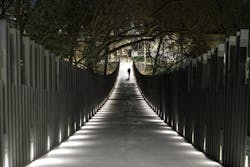Terrassa in Spain realizes uniform control of municipal SSL through drivers
LED driver manufacturer Tridonic has revealed details of a major municipal lighting project in Terrassa, Spain near Barcelona that involved the retrofit of 29,000 light points. Terrassa and its environmentally-conscious contractor imesAPI SA undertook the solid-state lighting (SSL) project knowing that it would involve many different luminaire types, with the goal of achieving uniform lighting and control capabilities. The duo accomplished the uniformity in look and control functionality by specifying Tridonic drivers for every luminaire.
The municipal lighting retrofit began in 2019 and was funded as part of a longer-running climate-protection project called Terrassa Energia Inteligente. The overall environmental project launched in 2013 with the goal of saving 17,000 MWh of electricity per year. Other elements of the project include installation of renewable energy assets, a fleet of hybrid buses, a modernized energy management system, and more.
Because the project involved so many different types of luminaires, a mix of manufacturers was essentially a requirement. Most of the project involved outdoor lighting, but the scope ranged from street lights to façade lighting to pedestrian area lighting (shown above). “In total, we have around 30 models from seven different suppliers in use,” says Albert Marín, smart city project manager for Terrassa. Manufacturers included large global suppliers such as Signify and Schréder and regional and specialty manufacturers including Novatilu, Carandini, and Disano.
As with many outdoor municipal projects, Terrassa wanted to install networked lighting controls with energy savings being a primary motive. We’ve covered the ROI achieved in many such projects such as in St. Gallen, Switzerland. Still, controls in a multi-vendor environment can be an issue with the industry just approaching the interoperability challenge. One path forward is through the scant interoperability-standards that have been developed. For example, Stockholm launched a project that requires all products deployed in the municipality be compliant with standards from the TALQ Consortium. TALQ enables islands of different network technologies to all be connected to the same CMS (central management system). But that doesn’t mean that all nodes in a municipal network have a similar set of luminaire functionality.
Terrassa’s municipal team wanted uniformity in terms of quality-of-light features. They wanted a street light, a wall grazer, and a pedestrian pathway light to all be able to dim along a similar chromaticity curve. The uniformity requirement essentially ensured all products would have the ability to perform energy-saving functions such as dimming late at night, or when no traffic was present, because the drivers utilized had to include baseline connectivity and intelligence.
Ultimately, all the new luminaires were equipped with drivers from the Tridonic ADV (advanced) product family. The drivers allow multiple ways of programming dimming curves. Tridonic has a dedicated programmer called the U6Me2. And the luminaires can be programmed using wireless NFC (near-field communications) or via the Tridonic ready2mains technology that operates over the power grid.
The installed luminaires have a mix of programmatic- and autonomous-control features and capabilities. For example, products installed near bus stops and train stations integrate occupancy sensors that raise light levels when pedestrians are present. Street lights can dim based on time of day to any one of eight levels and can also react to traffic.
“Thanks to new drivers, we have managed to unify and simplify control of our outdoor lighting — irrespective of the manufacturer and luminaire models used,” says the city’s Marín. “This means that our outdoor lighting is now extremely reliable and more efficient than ever before — an important milestone in the fight against climate change.”
The combination of efficient LED technology and controls has yielded an approximate 80% reduction in energy for the city’s outdoor lighting system. The city projects savings of 12,200 MWh annually. The success of the project has also prompted the city to plan a companion effort focused on indoor lighting, also under the Terrassa Energia Inteligente initiative.
LEDs Magazine chief editor MAURY WRIGHT is an electronics engineer turned technology journalist, who has focused specifically on the LED & Lighting industry for the past decade.
For up-to-the-minute LED and SSL updates, why not follow us on Twitter? You’ll find curated content and commentary, as well as information on industry events, webcasts, and surveys on our LinkedIn Company Page and our Facebook page.

Maury Wright | Editor in Chief
Maury Wright is an electronics engineer turned technology journalist, who has focused specifically on the LED & Lighting industry for the past decade. Wright first wrote for LEDs Magazine as a contractor in 2010, and took over as Editor-in-Chief in 2012. He has broad experience in technology areas ranging from microprocessors to digital media to wireless networks that he gained over 30 years in the trade press. Wright has experience running global editorial operations, such as during his tenure as worldwide editorial director of EDN Magazine, and has been instrumental in launching publication websites going back to the earliest days of the Internet. Wright has won numerous industry awards, including multiple ASBPE national awards for B2B journalism excellence, and has received finalist recognition for LEDs Magazine in the FOLIO Eddie Awards. He received a BS in electrical engineering from Auburn University.





